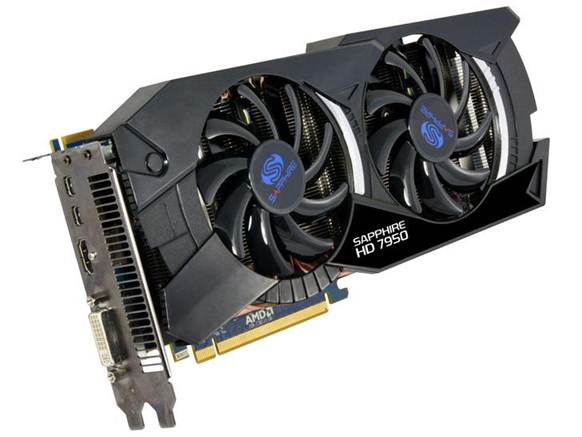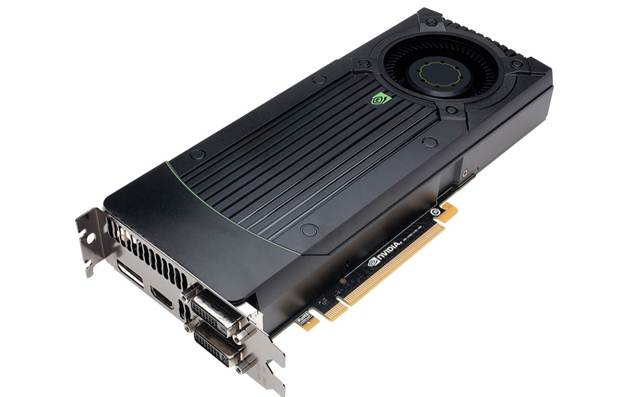The Radeon HD 7950 is yet another AMD card
that makes NVidia’ s range look both overpriced and power-hungry, offering
similar performance while demanding a lot less from both your power supply and
your wallet. It doesn’t just beat the performance of the GTX 580; it does so
while costing almost $48 less, depending on where you look.

Radeon
HD 7950
However, the Radeon HD 7950 is something of
a double-edged sword, because it’s so good that it actually starts to make it
look a little pointless to spend the extra on, for example, an HD 7970 or HD
6990. It costs substantially less than both of those cards, but performs almost
as well, especially if you’re into overclocking, because this is one of those
cards that’ll just give and give if massaged in the right way. Speeds of over
1GHz are not unreasonable even on the reference design.
The proprietary ZeroCore Power system
(which effectively disables the GPU when it isn’t needed) means it’ll even save
you money on your electricity bills. Although it’s hard to recommend outright
due to the high cost, there is one situation where it wins outright: if you
think the GeForce GTX 660 is too cheap for you, this is the card to go for.
$320 - $400: GeForce GTX 580
In terms of pounds to performance, the GTX
580 was one of the best NVidia cards around prior to the release of the GTX
660. Admittedly, it’s a level up in price terms, but you can just about find
them for $400 at the moment, and that’s only going to become easier to do in
the next few months.

GeForce
GTX 580
It’s arguably a little more powerful than
the average gamer might need, but in a way, that’s what makes it so attractive.
Even over 18 months after it was initially released, it’s still a formidable
card, and you won’t find a 6-series this powerful for anything approaching a
comparable price. The only downside is that in a world where the Radeon HD 7950
exists, there’s no good reason to buy it unless you have a personal dislike of
AMD.
Even so, at the time of its release, the
GTX 580 was the fastest single-GPU card around, and while it can be
outperformed by a pair of SLI cards, it remains one of the best you can get if
you only want to use one slot. Although you can successfully argue that anyone
spending this much on a card wants something right up to date, getting this
amount of raw power for under $400 makes it ultimately hard to complain too
much.
$400 - $481: GeForce GTX670
Although its shine has been slightly dulled
by the release of the similarly priced and powered GeForce GTX 660 Ti, the
GeForce GTX 670 still proves that when it comes to high-end cards, NVidia has
the edge over its rivals.

GeForce
GTX670
Although aimed at the high-end of the
market, it’s still fairly sanely priced at under $481. Certainly the near-grand
cost of the likes of the GeForce GTX 690 makes it look downright reasonable. It
has the same dynamic overclock power that the rest of NVidia’s high-end
600-series cards have, meaning you can get some strong gigahertz-level
performance if and when you need it. The dual-outputs (two DVI ports, as well
as DisplayPort and HDMI) mean it’s well suited for multi-monitor setups, and
the NVidia ‘Surround Mode’ allows you to use any combination of them.
As to why this is worth buying over its
Radeon counterparts, we can only point at performance benchmarks. The Radeon HD
7950 is a fair amount cheaper but almost 25% slower, putting it in a different
league. The Radeon HD 7970 is only slightly better, but it costs more than the
performance lift can justify. If you want to spend around $440 on a card,
there’s no question that this is the best you’ll find.
$481 and Above?
Here’s the thing. If you’re spending more
than $481 on a graphics card, you’re entering the sort of territory where two
cards running in SLI/CrossFireX mode will be cheaper and just as powerful.
There are graphics cards worth buying at this price level, certainly (the
GeForce GTX 680, the Radeon HD 7970 GHz Edition), but at this point you’re
paying as much to avoid the bother of overclocking your card than any actual
features.
Particularly if you already own a
half-decent card, it makes more sense as an upgrade strategy to buy a second
and run in SLI/CrossFireX, rather than install an entirely new card. Admittedly
it’s not the case every time, but if you’re planning to spend this amount on
graphics; all we can do is urge you to make sure you do your homework in order
to avoid the rapid onset of buyer’s remorse!